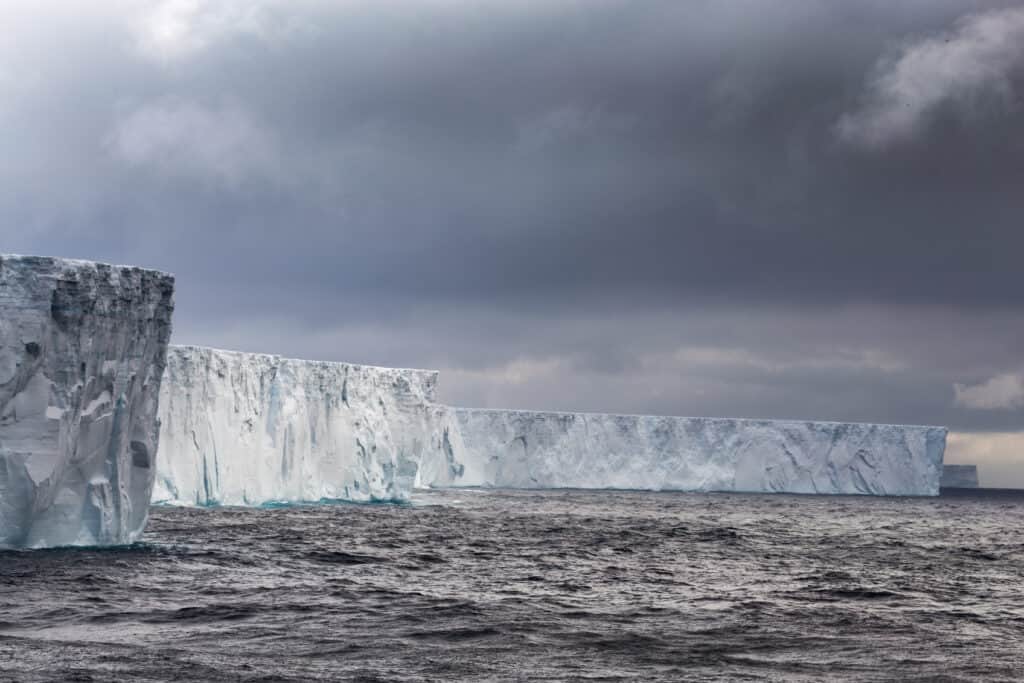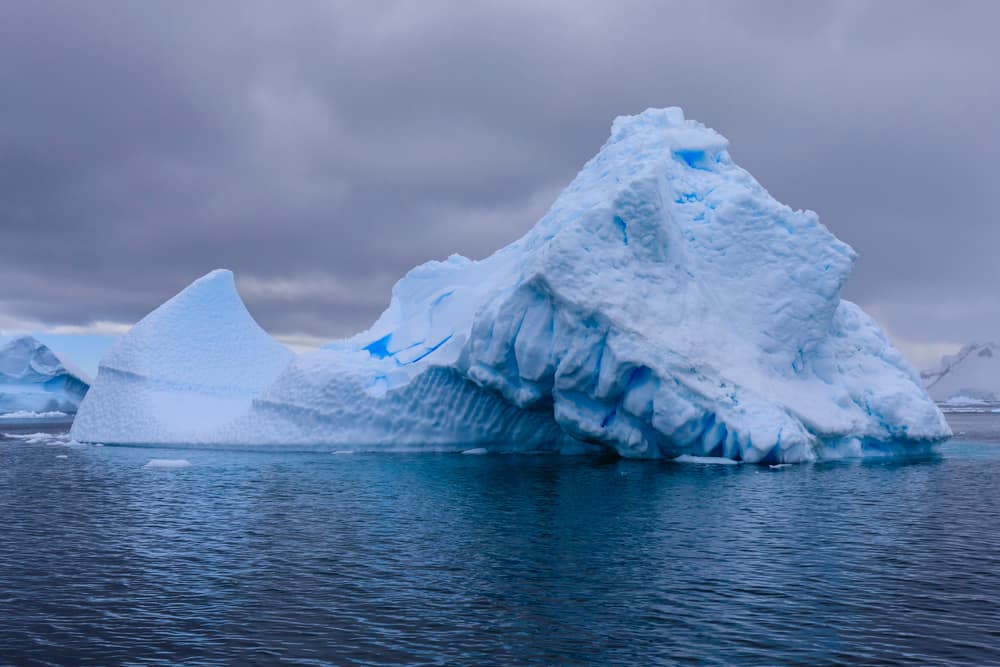The oceans are filled with incredible creatures, coral reefs, underwater volcanoes, and all sorts of other interesting natural formations. Still, many things in the ocean pose a hazard to human beings. While most people are more worried about shark attacks than they are icebergs, the latter still poses a threat. For the most part, icebergs are rather unremarkable to most people. In fact, if it wasn’t for the sinking of the RMS Titanic, the chances are most people wouldn’t even be aware of these ice formations. Nevertheless, we’re going to explore the largest iceberg in history, talk about where it was found, and show you just how large it was!
What Is an Iceberg?

Icebergs are most often found near Greenland and Antarctica.
©posteriori/Shutterstock.com
Before we can talk about the largest iceberg in history, we need to define an iceberg. Essentially, an iceberg is a mass of freshwater ice larger than 16ft across that has broken off from an ice shelf or glacier that floats in water. These icebergs can be massive in size, with some of the larger ones being bigger than cities like Manhattan!
Icebergs can pose a danger to ships as evidenced by the Titanic and many other ships that have sunk as a result of smashing into these ice formations. Part of the danger of icebergs stems from the fact that roughly one-tenth of an iceberg is visible above the surface of the water.
Not only is the majority of the iceberg underwater, but the shape of an iceberg is very hard to determine based on the portion of the ice showing above the ocean waves.
The result of so many fatal collisions with icebergs led to the development of the International Ice Patrol, an organization that monitors icebergs in the North Atlantic and Arctic Oceans. Their patrols and reports allow ships to cross major oceanic travel lanes and avoid potentially deadly accidents.
How Does an Iceberg Form?

Glaciers can calve icebergs
©iStock.com/Spaceliner
Icebergs form during a process called calving. That is when icebergs break off from ice shelves, glaciers, or even a larger iceberg. Most icebergs form in the North Atlantic Ocean near Greenland as well as near Antarctica in the Southern Ocean. However, once icebergs hit the water, they travel along with ocean currents.
Sometimes, they will travel out into the open sea and other times they will simply smash against the land from which they were calved. Icebergs usually begin to break up when they get to warmer waters. Warm air, rain, and ocean waters can make the iceberg break apart. When icebergs break, they are usually known as bergy bits or growlers.
Large icebergs are becoming more common in ocean waters as a result of warmer overall temperatures. According to the Goddard Institute for Space Studies at NASA, the overall temperature of the planet has increased about 1.4 degrees Fahrenheit since 1880.
The warmer temperatures make it easier for cracks to form in ice shelves and glaciers and for water on the ice’s surface to widen those cracks until they hit a breaking point. At the same time, more ice is melting below glaciers and ice sheets, speeding icebergs’ way into the ocean.
In other words, modern ships that take the same path as the Titanic have a lot more icebergs to worry about in the present times.
What is the Largest Iceberg in History?

The largest iceberg ever was 10 times bigger than New York City.
©robert mcgillivray/Shutterstock.com
The largest iceberg in history was iceberg B-15, a chunk of ice that measured 159 miles by 20 miles. This iceberg was a total of 3,200 square nautical miles. The iceberg was calved from the Ross Ice Shelf in Antarctica in 2000. Eventually, the iceberg broke up into two smaller pieces as it diminished in size over the next four years. A small piece of the iceberg still exists today.
While B-15 is recognized as the largest iceberg, it may not have been. Another potential titleholder for the largest iceberg in history was not given a name. Yet, it supposedly measured about 208 miles long and 60 miles wide (nautical miles).
If those dimensions were correct, the iceberg was larger than Haiti. The iceberg was found about 140 miles off the west coast of Scott Island in the Southern Ocean in 1956.
This iceberg was spotted by the crew of the USS Glacier. However, the validity of this iceberg’s size as the largest ever was challenged because the crew lacked modern devices to measure it. Specifically, the ship didn’t have satellite photography to confirm the overall size of the iceberg.
Other major icebergs that have existed include the 1,545-square-mile A-23A iceberg and the A-76 iceberg which measured 1,667 square miles.
How Big Was the Iceberg that Sank the RMS Titanic?

berg.
©Robert John Welch (1859-1936), official photographer for Harland & Wolff / public domain – License
The iceberg that sank the RMS Titanic was only about 400 feet long and perhaps 100 feet high at the time it collided with the ship. It could have been over a mile long before it made its way into the path of the Titanic.
Even that size pales in comparison to some of the icebergs that we have mentioned in this article. It wasn’t the largest iceberg in history that sank the Titanic; in fact, it was quite small. Nevertheless, that iceberg was enough to tear into a massive ship and sink it.
Now you can see why the International Ice Patrol was formed. Also, you know why we must continue to pour resources into tracking icebergs. Although the Titanic is often remembered as the worst iceberg sinking tragedy to occur in history, it’s not the only one. Thousands of lives have been lost as a result of icebergs and ships colliding. Some measure of protection must be granted to safeguard against these events.
What is the Largest Iceberg Today?

The largest iceberg that exists today is much smaller than the largest ever.
©Eleanor Scriven/Shutterstock.com
The largest iceberg that exists today is designated A-76, and it measures 89×14 nautical miles and has a total area of 1,680 square miles. This tabular iceberg broke away from the Ronne Ice Shelf in May 2021. The dimensions of this iceberg have been confirmed by satellite imagery, but it is beginning to break into several fragments.
Icebergs continue to be objects of great importance to those that travel in the oceans in which they are common. Fortunately, many resources are being utilized to identify and track icebergs. That way, we can continue to avoid collisions between ships and icebergs, saving human lives and precious cargo.
Up Next:
- From huge icebergs to huge animals… See Top 10 Biggest Animals That Ever Walked the Earth
The photo featured at the top of this post is © Maridav/Shutterstock.com
Thank you for reading! Have some feedback for us? Contact the AZ Animals editorial team.






